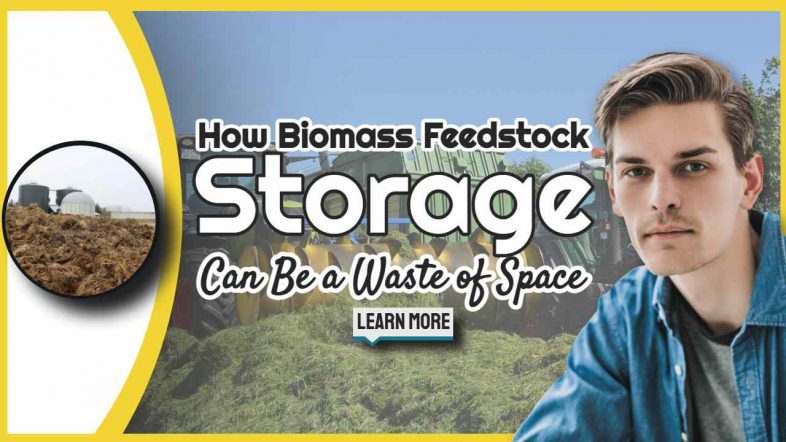Biomass feedstock storage (for example installing a silage clamp) is a new subject that is rising rapidly in prominence, following the recent expansion in the number of anaerobic digestion plants.
Current low-cost designs can easily be a shocking waste of space.
This fact is becoming clear now that there are many anaerobic digestion plants in operation.
Their operators would like to improve their uptime and profitability, and by doing so to serve their biomass and biowaste suppliers better, and raise profitability. But already land availability often limits what can be done.
Storage of the feed materials for biogas plants is becoming a new requirement with its own challenges. This needs to be recognised and the standards needed for ordinary silage storage need to be revised and enhanced for the requirements of the biogas industry.
In fact with 400 anaerobic digestion plants now in operation in the UK as announced by the Anaerobic Digestion & Bioresources Association (ADBA) [in 2015] AD is an industry in the making:
“The [UK] anaerobic digestion (AD) industry recently celebrated the passing of a huge industry milestone, with the announcement that over 400 biogas plants are now in operation as a result of over 600 per cent growth outside the water sector over the past five years.”
wrote Charlotte Morton, Chief Executive of the Anaerobic Digestion & Bioresources Association (ADBA) in 2015.
And, also to provide a sense of the scale of this, she said:
“In total, the AD industry now delivers a combined electrical equivalent capacity (electricity and biomethane) of over 514 megawatts. Thta's equivalent to the remaining capacity of one of the UK’s nuclear power plants, Wylfa, which is being decommissioned this year.”
Biomass Feedstock Storage Must Provide Good Quality Feed Materials Out of Season
All forms of biomass/ crop waste feedstocks are seasonal, which means that they have to be stored from the time of harvest until it is fed into the bioreactor for its conversion to bioenergy, or products such as biomethane.
An adequate volume of biomass feedstock storage is essential at all AD plants. It needs to be large enough to ensure that feed materials are always available to satisfy an AD Plant’s essential biological demand to be fed.
Providing a continuous supply of good quality feedstock will maintain the plant with low downtime, and reduce the risk of lost biogas production. Conversely, a lack of biogas output is inevitable should there ever be a shortage of a good “feedstock mix” for the daily digester feed.

The industry is also becoming much more aware that well-designed storage of biomass, such as a well-managed silage clamp, means preserving not only the original dry matter but also prevents decomposition.
If a stored feedstock begins to self-compost itself while stored much of the biogas potential is lost.
In addition, optimum storage should also include:
- preparing the organic material so that it is mixed into a homogeneous composition, and
- some sort of control over particle size, and
- ensuring a steady pH.
Importance of Biomass Feedstock Storage in the AD Plant Design Process

After all, at that stage, minds are necessarily focused on keeping to a tight budget. The aim is often just to get each AD project up and running.
Cheap and cheerful storage clamps are often built to start with. The simplest are shallow earth-bunded structures.
However, a variety of feedstock storage options are available, ranging from:
- relatively shallow open storage without any weather protection to
- closely controlled environments that are much deeper and optimise the use of space.
Good AD Plant Feed Material Storage Design
A good feedstock storage design is specific to the feedstock type to be stored. It should include consideration of the effects of:
- drying,
- compaction,
- sealing, and
- freezing,
on the resulting feed material properties.
The main factor in such a design will always be to avoid increasing the recalcitrance of a feedstock during digestion.
When all aspects of storage (such as providing a silage clamp) have been considered, finally it will be necessary:
- to provide an adequate storage volume to cater for seasonal low feedstock import, and
- minimise the risk of offensive odour being produced at any stage during;
- filling the store with organic material,
- storage, and
- transfer from storage into the biogas digester.
One feedstock storage solution provider has already become aware that good feed storage is now an issue that is critical. It's critical to the value-chain for biogas plants (as pre-cast concrete specialist White’s Concrete recently pointed out to us).
They have not been slow to rise to the challenge of providing solutions to satisfy this interest. They have developed their own feed storage alternatives to improve storage efficiency, as in the following Press Release in 2015:
Feedstock Storage Taking up too Much Space at AD Plants – Claim
According to one major designer and manufacturer of precast concrete parts for retaining and storage buildings,
“too much storage room is being used up for feedstock storage at AD facilities.”
According to Whites Concrete of Yorkshire, some wall designs might take up much too much space.
“On a big site, this may not appear to be a huge issue,”
said Stephen Casey, Project Engineer of Whites Concrete.
“However, with so many AD operators already adding more storage to their sites, space will soon be at a premium, so it seems foolish to create a problem that can be solved so easily.”
Casey cited a recent instance in which a customer requested a 48-metre storage width. To accomplish this, his designs indicated an overall construction width of 64 metres, requiring about 35% additional materials, expenditures, and space.

Whites' spokesperson went on to explain that plant owners should be looking ahead much further when designing feedstock storage improvements. Careful specification and selection of biomass feedstock storage location are so important.
It is easy to forget that most AD Plants will still be around in a couple of decades time.
There is already an increasing demand for a higher quality biogas output, with examples such as biogas upgrading to biomethane rising in popularity.
Many biogas plants have site footprints that are already fully utilized. Thus, the chances are high that the average AD plant operator/ owner will need to find room for a lot of additional biogas processing equipment between now and 20 years time.
PR Ends
In the short and long term, inappropriate use of space could make further investment problematic.
[Article first posted in September 2015. Updated August 2021.]







As a farmer myself, I don’t agree. You need to understand the relief of having extra space for crops and supplies. Storage like this has a lot of potential uses. More feed storage space simply provides greater flexibility across your operation. When combined with a new cattle shed, a farm is ready for whatever the future may bring.